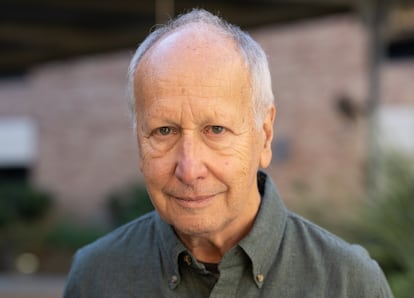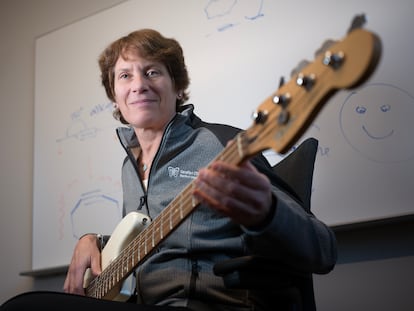Argentina’s Luis Caffarelli wins ‘Nobel’ of mathematics for illuminating what happens in a glass with ice
The researcher, the first Latin American to win the Abel Prize, uncovered the interactions between solids and liquids, opening new doors to medicine, the automotive industry and even knowledge of the universe

Argentine mathematician Luis Caffarelli, 74 years old, from Buenos Aires, loses himself when talking about a glass of ice. As the ice cubes melt, he explains enthusiastically, their edges become rounded, gradually creating a new world on the border between solid and liquid, a convoluted universe with changing energies and geometries. Caffarelli has been immersed in this type of microcosm for more than four decades and has managed to describe them mathematically, with increasing precision. This Wednesday he won the Abel Prize for his work, considered the Nobel Prize of mathematics and endowed with 7.5 million Norwegian kroner (about $647,300).
“You can’t reach the truth, but at least you can get closer to it, to the complexity of reality,” he says by videoconference from his home in the U.S. city of Austin, where he has been doing research for a quarter of a century at the University of Texas. The Norwegian Academy of Science and Letters, which awards the prize, has highlighted his “technically virtuous” results, especially in the so-called free boundary problems, such as those mathematical models of what happens at the contact surface between water and ice, or in an alloy of different molten metals that solidify at different rates. Caffarelli has also shone by delving into the Navier-Stokes equations, which describe since 1845 the flow of a viscous fluid, such as oil. The applications of his work are incalculable: the analysis of a person’s blood circulation, the prediction of the movement of oil, the manufacture of an automobile engine, financial mathematics, the refinement of the fundamental models that explain the universe.
Caffarelli received his PhD from the University of Buenos Aires in 1972 and immediately emigrated on a scholarship to the United States, spending a decade at the legendary Institute for Advanced Study in Princeton, where the German physicist Albert Einstein fled from the Nazis. “Mathematics linked to physics is the most interesting. I am not very much in favor of doing super-abstract research that only half a dozen mathematicians can understand,” says the Argentine, who has close ties to Spain and is a member of the scientific advisory committee of the Institute of Mathematical Sciences (ICMAT) in Madrid.
The researcher recalls that his first visit to the Spanish capital was in 1984, at the height of the countercultural explosion after the Franco regime, although his interests were different. “The Madrid movida was not as important as Madrid food,” he jokes. Caffarelli uncovered the interactions between solids and liquids with the help of Spanish colleagues such as Antonio Córdoba, Ireneo Peral, Juan Luis Vázquez and Fernando Soria. Córdoba, former director of the ICMAT, describes as “classic and revolutionary” the Argentinean’s contributions in the field of partial differential equations, tools used in the mathematical description of the physical world of everyday life, such as fluids in motion. The Buenos Aires native is the first Latin American to win the Abel Prize, an award established in 2002 by the Norwegian government to fill the mathematical gap left by the Nobel Prizes.
Caffarelli and Córdoba coincided at Princeton with another Spaniard, the economist Ernest Lluch, father of universal public health care in Spain — as minister in the first Socialist government — and then rector of the Menéndez Pelayo International University. The three of them devised a successful summer school of mathematics at the Palacio de la Magdalena in Santander, which ended when the terrorist group ETA murdered Ernest Lluch with two shots to the head in the garage of his home on November 21, 2000. Córdoba recalls that Caffarelli even bought a plot of land in the mountains of Madrid, in Soto del Real, to build a house with his wife, the also brilliant mathematician Irene Martínez Gamba. In the end, the couple stayed in the United States.
The Argentine researcher recalls that time with nostalgia. “Madrid was, scientifically, one of the most interesting places, perhaps because it was a combination of doing mathematics and the very friendly life we had among us. Speaking the same language made it much easier to have deep scientific discussions,” he recalls. Caffarelli has lived in Madrid for months-long periods since the 1980s, but at the end of each day of mathematical debate, there was never a glass of ice in his hand. “If you want to drink, in Spain you drink good wine,” he says with a chuckle.
Sign up for our weekly newsletter to get more English-language news coverage from EL PAÍS USA Edition
Tu suscripción se está usando en otro dispositivo
¿Quieres añadir otro usuario a tu suscripción?
Si continúas leyendo en este dispositivo, no se podrá leer en el otro.
FlechaTu suscripción se está usando en otro dispositivo y solo puedes acceder a EL PAÍS desde un dispositivo a la vez.
Si quieres compartir tu cuenta, cambia tu suscripción a la modalidad Premium, así podrás añadir otro usuario. Cada uno accederá con su propia cuenta de email, lo que os permitirá personalizar vuestra experiencia en EL PAÍS.
¿Tienes una suscripción de empresa? Accede aquí para contratar más cuentas.
En el caso de no saber quién está usando tu cuenta, te recomendamos cambiar tu contraseña aquí.
Si decides continuar compartiendo tu cuenta, este mensaje se mostrará en tu dispositivo y en el de la otra persona que está usando tu cuenta de forma indefinida, afectando a tu experiencia de lectura. Puedes consultar aquí los términos y condiciones de la suscripción digital.
More information
Últimas noticias
The new victims of the Republican war on Obamacare: Millions hit by soaring health insurance premiums
A country divided on migrant rights: Some US states expand protections while others restrict them
Venezuela authorizes the release of another 87 political prisoners
There is as much life left to discover on planet Earth as that which is already known
Most viewed
- David King, chemist: ‘There are scientists studying how to cool the planet; nobody should stop these experiments from happening’
- Reinhard Genzel, Nobel laureate in physics: ‘One-minute videos will never give you the truth’
- Oona Chaplin: ‘I told James Cameron that I was living in a treehouse and starting a permaculture project with a friend’
- Sinaloa Cartel war is taking its toll on Los Chapitos
- The Interoceanic Train, the Mexican alternative to the Panama Canal











































